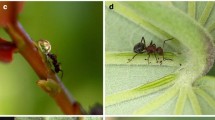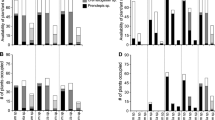Abstract
The impact of mutualists on a partner’s demography depends on how they affect the partner’s multiple vital rates and how those vital rates, in turn, affect population growth. However, mutualism studies rarely measure effects on multiple vital rates or integrate them to assess the ultimate impact on population growth. We used vital rate data, population models and simulations of long-term population dynamics to quantify the demographic impact of a guild of ant species on the plant Ferocactus wislizeni. The ants feed at the plant’s extrafloral nectaries and attack herbivores attempting to consume reproductive organs. Ant-guarded plants produced significantly more fruit, but ants had no significant effect on individual growth or survival. After integrating ant effects across these vital rates, we found that projected population growth was not significantly different between unguarded and ant-guarded plants because population growth was only weakly influenced by differences in fruit production (though strongly influenced by differences in individual growth and survival). However, simulations showed that ants could positively affect long-term plant population dynamics through services provided during rare but important events (herbivore outbreaks that reduce survival or years of high seedling recruitment associated with abundant precipitation). Thus, in this seemingly clear example of mutualism, the interaction may actually yield no clear benefit to plant population growth, or if it does, may only do so through the actions of the ants during rare events. These insights demonstrate the value of taking a demographic approach to studying the consequences of mutualism.





Similar content being viewed by others
References
Alma AM, Pol RG, Pacheco LF, Vázquez DP (2015) No defensive role of ants throughout a broad latitudinal and elevational range of a cactus. Biotropica 47:347–354. doi:10.1111/btp.12211
Aslan CE, Zavaleta ES, Croll D, Tershy B (2012) Effects of native and non-native vertebrate mutualists on plants. Conserv Biol 26:778–789. doi:10.1111/j.1523-1739.2012.01885.x
Bowers JE (1997) Demographic patterns of Ferocactus cylindraceus in relation to substrate age and grazing history. Plant Ecol 133:37–48. doi:10.1023/A:1009767621391
Bowers J (2000) Does Ferocactus wislizeni (Cactaceae) have a between-year seed bank? J Arid Environ 45:197–205. doi:10.1006/jare.2000.0642
Bowers J, Pierson E (2001) Implications of seed size for seedling survival in Carnegiea gigantea and Ferocactus wislizeni (Cactaceae). Southwest Nat 46:272–281. doi:10.2307/3672423
Brodie JF, Helmy OE, Brockelman WY, Maron JL (2009) Bushmeat poaching reduces the seed dispersal and population growth rate of a mammal-dispersed tree. Ecol Appl 19:854–863. doi:10.1890/08-0955.1
Bronstein JL (2001) The costs of mutualism. Am Zool 41:825–839. doi:10.1668/0003-1569(2001)041[0825:TCOM]2.0.CO;2
Bruna EM (2003) Are plant populations in fragmented habitats recruitment limited? Tests with an Amazonian herb. Ecology 84:932–947. doi:10.1890/0012-658(2003)084[0932:APPIFH]2.0.CO;2
Bruna EM, Izzo TJ, Inouye BD, Vasconcelos HL (2014) Effect of mutualist partner identity on plant demography. Ecology 95:3237–3243. doi:10.1890/14-0481.1
Burnham KP, Anderson DR (2002) Model selection and multimodel inference: a practical information-theoretic approach. Springer, New York
Caswell H (2001) Matrix population models: construction, analysis and interpretation, 2nd edn. Sinauer, Sunderland
Cayan DR, Tyree M, Kunkel KE, Castro C, Gershunov A, Barsugli J, Ray AJ, Overpeck J, Anderson M, Russell J, Rajagopalan B, Rangwala I, Duffy P (2013) Future climate: projected average. In: Garfin G, Jardine A, Merideth R, Black M, LeRoy S (eds) Assessment of climate change in the Southwest United States: a report prepared for the National Climate Assessment. Island Press, Washington, DC, pp 101–125
Chamberlain SA, Holland JN (2009) Quantitative synthesis of context dependency in ant-plant protection mutualisms. Ecology 90:2384–2392. doi:10.1890/08-1490.1
Chamberlain SA, Bronstein JL, Rudgers JA (2014) How context dependent are species interactions? Ecol Lett 17:881–890. doi:10.1111/ele.12279
Coulson T (2012) Integral projections models, their construction and use in posing hypotheses in ecology. Oikos 121:1337–1350. doi:10.1111/j.1600-0706.2012.00035.x
Drezner T (2004) Saguaro recruitment over their American range: a separation and comparison of summer temperature and rainfall. J Arid Environ 56:509–524. doi:10.1016/S014-1963(03)00064-8
Drezner T, Balling R (2002) Climatic controls of saguaro (Carnegiea gigantea) regeneration: a potential link with El Niño. Phys Geogr 23:465–475. doi:10.2747/0272-3646.23.6.465
Easterling M, Ellner S, Dixon P (2000) Size-specific sensitivity: applying a new structured population model. Ecology 81:694–708. doi:10.1890/0012-9658(2000)081[0694:SSSAAN]2.0.CO;2
Ehrlén J (2002) Assessing the lifetime consequences of plant-animal interactions for the perennial herb Lathyrus vernus (Fabaceae). Perspect Plant Ecol Evol Syst 5:145–163. doi:10.1078/1433-8319-00031
Ellner S, Rees M (2006) Integral projection models for species with complex demography. Am Nat 167:410–428. doi:10.1086/499438
Feldman TS, Morris WF (2011) Higher survival at low density counteracts lower fecundity to obviate Allee effects in a perennial plant. J Ecol 99:1162–1170. doi:10.1111/j.1365-2745.2011.01855.x
Fitzpatrick G, Davidowitz G, Bronstein JL (2013) An herbivore’s thermal tolerance is higher than that of the ant defenders in a desert protection mutualism. Sociobiology 60:252–258. doi:10.13102/sociobiology.v60i3.252-258
Geib JC, Galen C (2012) Tracing impacts of partner abundance in facultative pollination mutualisms: from individuals to populations. Ecology 93:1581–1592. doi:10.1890/11-1271.1
Godinez-Alvarez H, Valiente-Banuet A, Rojas-Martinez A (2002) The role of seed dispersers in the population dynamics of the columnar cactus Neobuxbaumia tetetzo. Ecology 83:2617–2629. doi:10.2307/3071819
Hoeksema JD, Chaudhary VB, Gehring CA, Johnson NC, Karst J, Koide RT, Pringle A, Zabinski C, Bever JD, Moore JC, Wilson GWT, Klironomos JN, Umbanhowar J (2010) A meta-analysis of context-dependency in plant response to inoculation with mycorrhizal fungi. Ecol Lett 13:394–407. doi:10.1111/j.1461-0248.2009.01430.x
Holland JN, Molina-Freaner F (2013) Hierarchical effects of rainfall, nurse plants, granivory and seed banks on cactus recruitment. J Veg Sci 24:1053–1061. doi:10.1111/jvs.12021
Jordan PW, Nobel PS (1981) Seedling establishment of Ferocactus acanthodes in relation to drought. Ecology 62:901–906. doi:10.2307/1936987
Jordan PW, Nobel PS (1982) Height distributions of two species of cacti in relation to rainfall, seedling establishment, and growth. Bot Gaz 143:511–517
Karst J, Marczak L, Jones MD, Turkington R (2008) The mutualism-parasitism continuum in ectomycorrhizas: a quantitative assessment using meta-analysis. Ecology 89:1032–1042. doi:10.1890/07-0823.1
Lanan MC, Bronstein JL (2013) An ant’s-eye view of an ant-plant protection mutualism. Oecologia 172:779–790. doi:10.1007/s00442-012-2528-0
Mann J (1969) Cactus-feeding insects and mites. In: United States National Museum Bulletin, vol 256. Smithsonian Institution, Washington
Marazzi B, Bronstein JL, Koptur S (2013) The diversity, ecology and evolution of extrafloral nectaries: current perspectives and future challenges. Ann Bot 111:1243–1250. doi:10.1093/aob/mct109
Mayer VE, Frederickson ME, McKey D, Blatrix R (2014) Current issues in the evolutionary ecology of ant-plant symbioses. New Phytol 202:749–764. doi:10.1111/nph.12690
Merow C, Dahlgren JP, Metcalf CJE, Childs DZ, Evans MEK, Jongejans E, Record S, Rees M, Salguero-Gomez R, McMahon SM (2014) Advancing population ecology with integral projection models: a practical guide. Methods Ecol Evol 5:99–110. doi:10.1111/2041-210X.12146
Miller TEX, Louda SM, Rose KA, Eckberg JO (2009) Impacts of insect herbivory on cactus population dynamics: experimental demography across an environmental gradient. Ecol Monogr 79:155–172. doi:10.1890/07-1550.1
Morris WF, Doak DF (2002) Quantitative conservation biology: theory and practice of population viability analysis. Sinauer, Sunderland
Morris WF, Wilson WG, Bronstein JL, Ness JH (2005) Environmental forcing and the competitive dynamics of a guild of cactus-tending ant mutualists. Ecology 86:3190–3199. doi:10.1890/05-0465
Morris WF, Hufbauer RA, Agrawal AA, Bever JD, Borowicz VA, Gilbert GS, Maron JL, Mitchell CE, Parker IM, Power AG, Torchin ME, Vazquez DP (2007) Direct and interactive effects of enemies and mutualists on plant performance: a meta-analysis. Ecology 88:1021–1029. doi:10.1890/06-0442
Ness JH (2006) A mutualism’s indirect costs: the most aggressive plant bodyguards also deter pollinators. Oikos 113:506–514. doi:10.1111/j.2006.0030-1299.14143.x
Ness JH, Morris WF, Bronstein JL (2006) Integrating quality and quantity of mutualistic service to contrast ant species protecting Ferocactus wislizeni. Ecology 87:912–921. doi:10.1890/0012-9658(2006)87[912:IQAQOM]2.0.CO;2
Palmer TM, Doak DF, Stanton ML, Bronstein JL, Kiers ET, Young TP, Goheen JR, Pringle RM (2010) Synergy of multiple partners, including freeloaders, increases host fitness in a multispecies mutualism. Proc Natl Acad Sci USA 107:17234–17239. doi:10.1073/pnas.1006872107
Parker IM (1997) Pollinator limitation of Cytisus scoparius (Scotch broom), an invasive exotic shrub. Ecology 78:1457–1470. doi:10.1890/0012-9658(1997)078[1457:PLOCSS]2.0.CO;2
Pierson EA, Turner RM, Betancourt JL (2013) Regional demographic trends from long-term studies of saguaro (Carnegiea gigantea) across the northern Sonoran Desert. J Arid Environ 88:57–69. doi:10.1016/j.jaridenv.2012.08.008
R Core Team (2014) R: a language and environment for statistical computing. R Foundation for Statistical Computing, Vienna
Rodriguez-Perez J, Traveset A (2012) Demographic consequences for a threatened plant after the loss of its only disperser. Habitat suitability buffers limited seed dispersal. Oikos 121:835–847. doi:10.1111/j.1600-0706.2011.19946.x
Rosumek FB, Silveira FAO, Neves FdS, Barbosa NPdU, Diniz L, Oki Y, Pezzini F, Fernandes GW, Cornelissen T (2009) Ants on plants: a meta-analysis of the role of ants as plant biotic defenses. Oecologia 160:537–549. doi:10.1007/s00442-009-1309-x
Rudgers JA, Strauss SY (2004) A selection mosaic in the facultative mutualism between ants and wild cotton. Proc R Soc B Biol Sci 271:2481–2488. doi:10.1098/rspb.2004.2900
Rudgers JA, Miller TEX, Ziegler SM, Craven KD (2012) There are many ways to be a mutualist: endophytic fungus reduces plant survival but increases population growth. Ecology 93:565–574. doi:10.1890/11-0689.1
Sachs JL, Simms EL (2006) Pathways to mutualism breakdown. Trends Ecol Evol 21:585–592. doi:10.1016/j.tree.2006.06.018
Saikkonen K, Saari S, Helander M (2010) Defensive mutualism between plants and endophytic fungi? Fungal Divers 41:101–113. doi:10.1007/s13225-010-0023-7
Shreve F (1929) Changes in desert vegetation. Ecology 10:364–373. doi:10.2307/1931144
Silvertown J, Franco M (1993) Plant demography and habitat: a comparative approach. Plant Species Biol 8:67–73. doi:10.1111/j.1442-1984.1993.tb00058.x
Stachowicz JJ (2001) Mutualism, facilitation, and the structure of ecological communities. Bioscience 51:235–246. doi:10.1641/0006-3568(2001)051[0235:MFATSO]2.0.CO;2
Stanton ML, Palmer TM (2011) The high cost of mutualism: effects of four species of East African ant symbionts on their myrmecophyte host tree. Ecology 92:1073–1082. doi:10.1890/10-1239.1
Trager MD, Bhotika S, Hostetler JA, Andrade GV, Rodriguez-Cabal MA, McKeon CS, Osenberg CW, Bolker BM (2010) Benefits for plants in ant-plant protective mutualisms: a meta-analysis. PLoS One 5:e14308. doi:10.1371/journal.pone.0014308
Turner RM (1990) Long-term vegetation change at a fully protected Sonoran Desert site. Ecology 71:466–477. doi:10.2307/1940301
Weber MG, Keeler KH (2013) The phylogenetic distribution of extrafloral nectaries in plants. Ann Bot 111:1251–1261. doi:10.1093/aob/mcs225
Zhang S, Zhang Y, Ma K (2012) The ecological effects of the ant-hemipteran mutualism: a meta-analysis. Basic Appl Ecol 13:116–124. doi:10.1016/j.baae.2012.02.002
Acknowledgments
We thank K. Bressmer, C. Gibson, M. Lanan, H. McNelis, A. Reed and L. Sturdivant for assistance in the field. We also thank G. Davidowitz and M. Lanan for their insight into the insect community that interacts with F. wislizeni. Thank you to the reviewers and editors for helpful suggestions. This work was supported by a National Science Foundation Graduate Research Fellowship (DGE-0718124) and a grant from the Seattle chapter of the ARCS Foundation to K. R. F., and by National Science Foundation grant DEB-0716433 to W. F. M.
Conflict of interest
The authors declare no conflict of interest.
Author information
Authors and Affiliations
Corresponding author
Additional information
Communicated by Candace Galen.
Electronic supplementary material
Below is the link to the electronic supplementary material.
Rights and permissions
About this article
Cite this article
Ford, K.R., Ness, J.H., Bronstein, J.L. et al. The demographic consequences of mutualism: ants increase host-plant fruit production but not population growth. Oecologia 179, 435–446 (2015). https://doi.org/10.1007/s00442-015-3341-3
Received:
Accepted:
Published:
Issue Date:
DOI: https://doi.org/10.1007/s00442-015-3341-3




